The “Snow Monkey Express” was almost empty when I rode with a few other tourists from Nagano to the last stop in Yamanouchi, a town of 12,400. A banner welcomed us to the “Snow Monkey Town,” and signs in the station showed red-faced Japanese macaques soaking up to their necks in hot-spring water. The monkeys closed their eyes and stretched their arms as steam rose around them and snowflakes settled in the dry fur on their heads.
After the long day of travel, I decided to take a dip myself in one of the town’s onsen baths. I lowered myself into the scalding sulfuric water and thought of similar bathing experiences I’d had in other places: the fragrant moist heat of the Russian banya or the Indian Ayurvedic steam bath in its coffinlike booth. Over the centuries, people worldwide have differentiated the simple practice of bathing into many elaborate forms. Japanese primatologists were the first to ask whether animals have developed rituals of their own.
The snow monkeys are one of several groups of Japanese macaques that have changed the way we see animals and ourselves. They’ve helped us to recognize the true complexity of animal behavior—and, in doing so, offered insight into the evolutionary origins of ours. I planned to visit several of these monkey troops throughout Japan and started with this “Snow Monkey Town” because, well, its monkeys were the cutest.
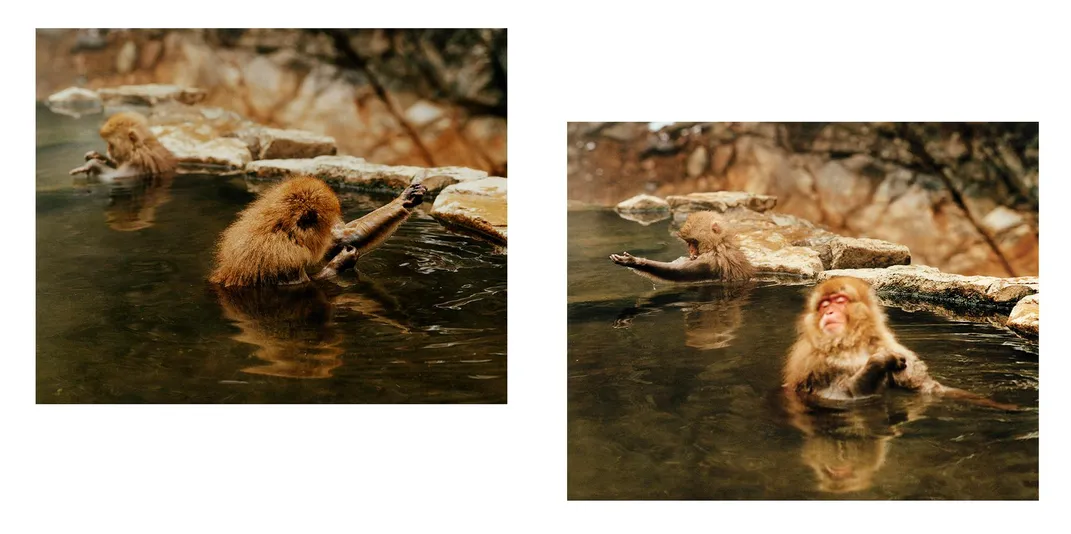
The next morning, I walked several miles through the forest to the Jigokudani Monkey Park, where a sign for a “monkey onsen” pointed over a footbridge. The pool steamed on the edge of a cliff over the Yokoyu River, and a single monkey sat at its center, an old female with a long muzzle and round amber eyes. She was one of about 40 macaques who sometimes used the bath. Other monkeys were squabbling over the grain that workers at the monkey park had spread on the riverbank and mountainside.
The photos I’d seen before the trip gave an impression of relaxed little animals, but the scene was anything but Zen. Scientists describe Japanese macaque societies as “despotic” and “nepotistic.” Every monkey in a given group had a place in a linear dominance hierarchy, one for males and one for females, and they constantly displaced inferiors to reinforce their rank. The monkeys were vigilant as they picked grain from the snow, constantly looking over their shoulders to keep tabs on their neighbors: A higher-ranking monkey might drag them by the leg or sink its teeth into their neck.
As mealtime wound down, the monkeys began to groom each other—their way to not only eliminate parasites but also placate a superior or form an alliance. A few juveniles jumped into the onsen, while adult females waded in more carefully. I crouched in front of a female macaque, who gripped a rock with both hands and plunged her hindquarters underwater. Her adolescent son squatted behind her while her infant daughter paddled by her side. The son combed through her fur, first with his left hand and then his right, working through her gray undercoat to the white skin and eating the morsels he found inside. The mother closed her bluish eyelids and rested her red cheek on the rock between her hands. Her name was Tomiko, a park worker told me. “Tomiko very like onsen,” he explained.
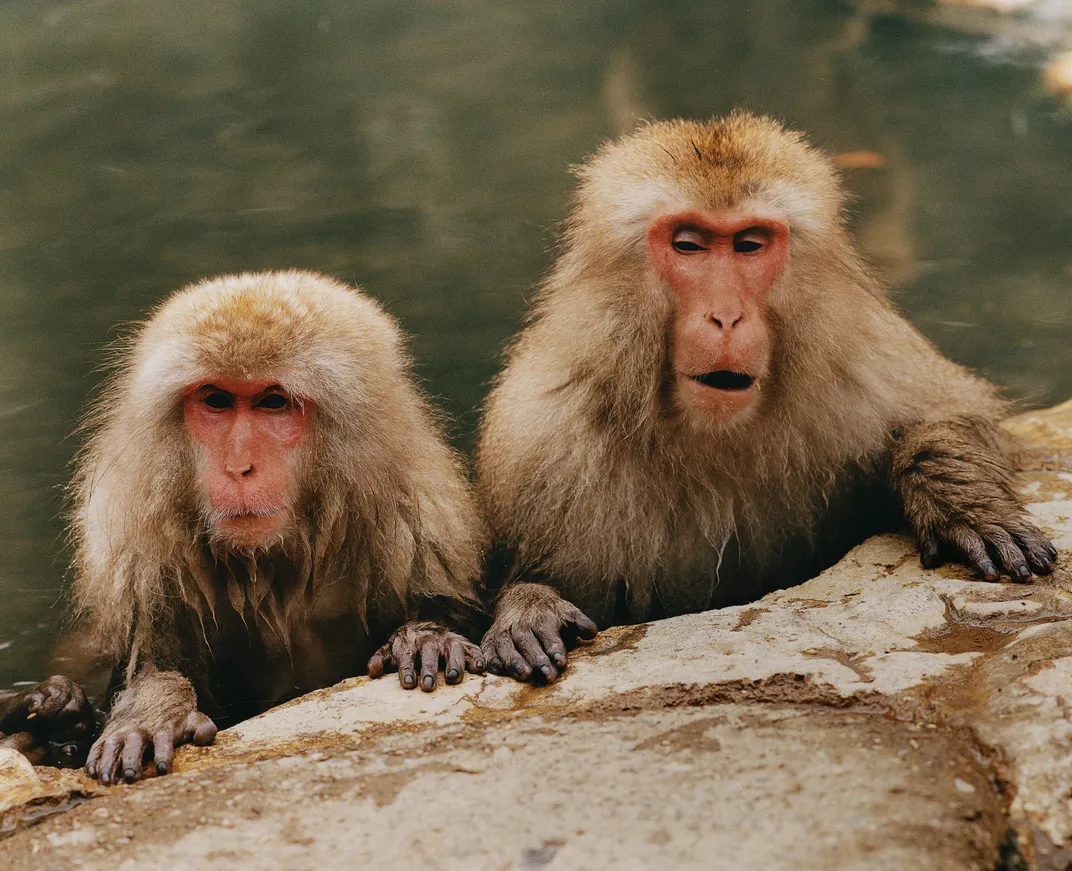
Monkeys like Tomiko started to bathe at the onsen at Jigokudani nearly 60 years ago. “I was the first to see them go in,” a retired professor named Kazuo Wada from the Primate Research Institute at Kyoto University told me. The year was 1963, he said, and he was studying the monkeys at Jigokudani. The park at that time provisioned a group of 23 monkeys with apples near an outdoor onsen for guests of a local ryokan, a traditional Japanese inn. The monkeys avoided the water until one day, an apple rolled into the bath. “A monkey went after it and realized it was warm,” Wada recalled. The monkey took another dip a few minutes later. Young monkeys watching from the edge became curious and soon tried the onsen for themselves.
Both scientists and locals had been watching the Jigokudani monkeys for years, but no one had seen them enter the water until that moment. Within a few months, bathing was popular with the younger monkeys in the group. It was more than just a fad. Their babies learned to swim as well. Eventually, a third of all monkeys in the troop were bathing. In 1967, the park had to build a dedicated monkey onsen nearby for hygienic reasons, to make sure they weren’t bathing with humans.
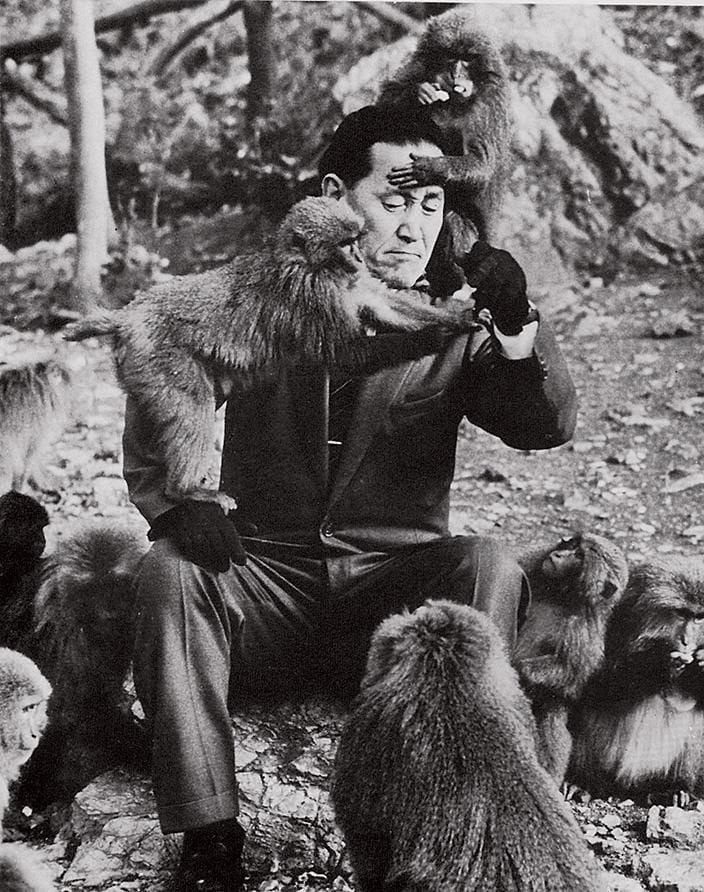
“Monkey see, monkey do” is usually a derisive phrase for learning by imitation, but scientists at Jigokudani believed they were witnessing something profound. They were disciples of Kinji Imanishi, an ecologist and anthropologist who co-founded the Primate Research Institute in 1967. While Western scientists viewed life as a Darwinian struggle for survival, Imanishi believed harmony undergirded nature, and that culture was one expression of this harmony. He predicted you would find a simple form of culture in any animals that lived in a “perpetual social group” where individuals learned from one another and stayed together over many generations. Anthropologists had never paid attention to animals because most of them assumed “culture” was strictly a human endeavor. Starting in the 1950s, Imanishi’s students at Jigokudani and other sites across Japan discovered that was not the case.
* * *
Nowadays cultures have been recognized not just in monkeys but in various mammals, birds and even fish. Like people, animals rely on social customs and traditions to preserve important behaviors that individuals do not know by instinct and cannot figure out on their own. The spread of these behaviors is determined by the animals’ social relationships—the ones they spend time with and the ones they avoid—and it varies among groups. Researchers have tallied nearly 40 different behaviors in chimpanzees that they deemed to be cultural, from a group in Guinea that cracks nuts to another in Tanzania that dances in the rain. Sperm whale scientists have identified distinct vocal clans with their own dialects of clicks, creating what one scientist called “multicultural areas” in the sea.
Culture is so important to some animals that Andrew Whiten, an evolutionary and developmental psychologist at the University of St. Andrews in Scotland, has called it a “second inheritance system” alongside genetics. And when animals disappear, so do the cultures they have evolved over generations. Conservation programs can sometimes reintroduce new animals to a habitat, but these newcomers know none of the cultural behaviors of their predecessors. In 2019, the journal Science published two papers arguing that conservation efforts have traditionally overlooked the impact of human activity on behavioral and cultural diversity in animals. The authors of one paper urged the creation of “cultural heritage sites” for chimpanzees, orangutans and whales.
The papers did not mention Japanese macaques, which are not a threatened species. But the proposal of cultural heritage sites for animals made me think immediately of Japan, where Imanishi and his students had learned to recognize animal cultures in the first place. I headed from Jigokudani to the most storied of their field sites, an island called Koshima, my next destination.
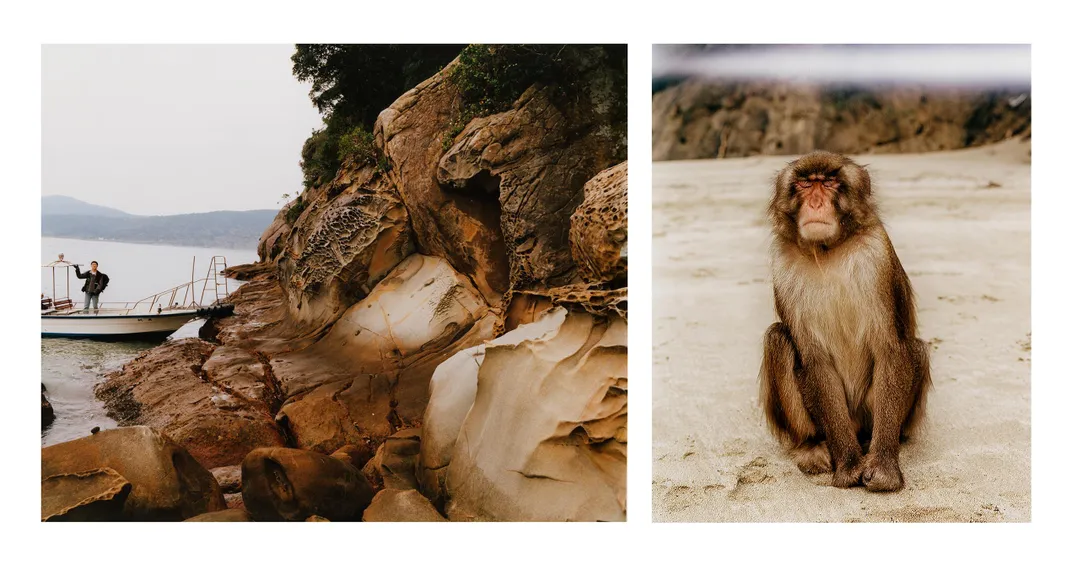
From Jigokudani, I passed through Kyushu, the southernmost of Japan’s four main islands, and rode an old bus down the Pacific coast. Small homes hid behind their gardens on the roadside, and mountains rose to embrace the water in round blue bays. The region had once been popular with Japanese honeymooners, but its golden age ended when it became easy to fly to places like Hawaii. I got off the bus by the field station that had been established in 1967 by the Primate Research Institute and is now managed by Kyoto University.
An American student named Nelson Broche Jr. met me at the bus stop. He was studying acute stress in Japanese macaques at the Koshima Field Center. “One thing people don’t give macaques credit for is they’re the most successful primates after humans,” he told me. You can find different species of macaques throughout all of Asia, including in the hearts of massive cities like Delhi. Japanese macaques have adapted to nearly every natural habitat in the country, from the snowy mountains of Jigokudani to the subtropical forests on Kyushu.
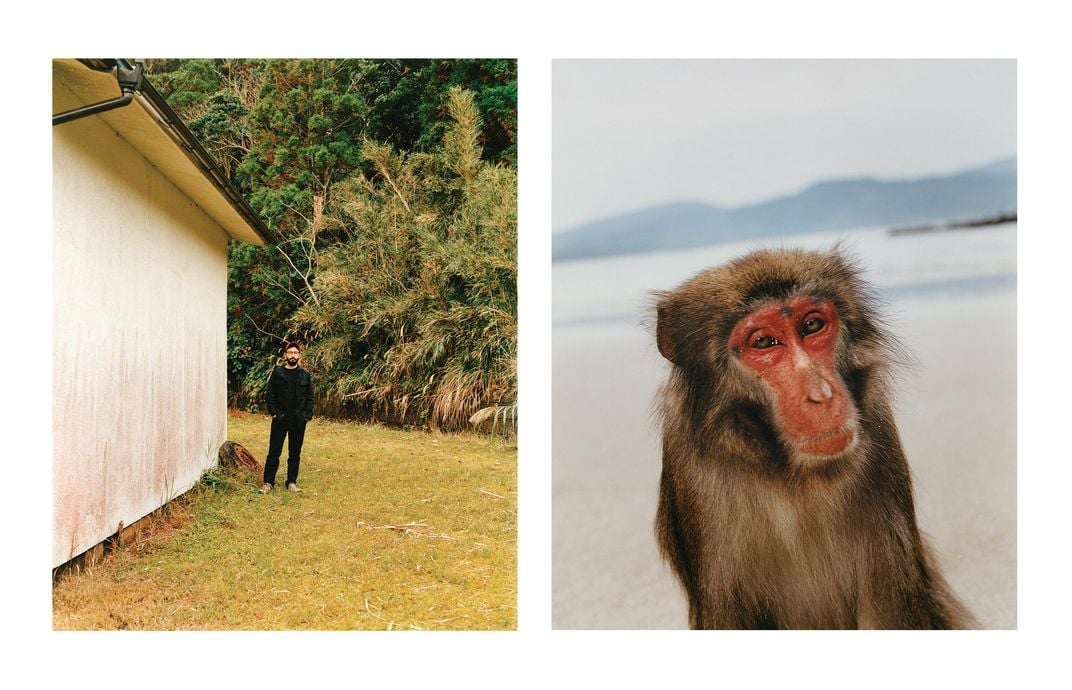
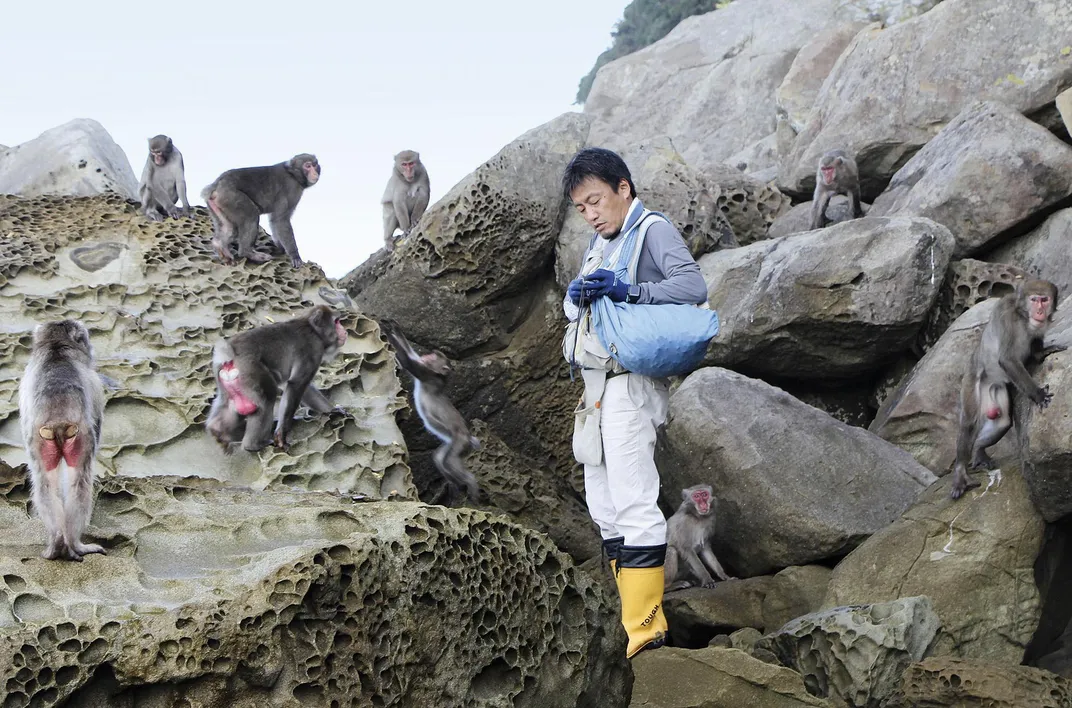
Broche introduced me to Takafumi Suzumura, who has been working on Koshima for the university for 18 years. We walked to the water, and they pointed to Koshima, a lump of green forest in a calm turquoise sea. It was so close that surfers could swim there. We paid a fisherman to pilot us around the rocky shoreline to a hidden inlet with a beach.
The monkeys were waiting on the sand, like survivors of a shipwreck. They started to coo and whir as soon as we appeared. “This means, ‘Give me food,’” Suzumura said. The alpha male Shika strutted up to Suzumura with his tail pointed in the air and chased away any other monkey who got too near. Unlike the monkeys at Jigokudani, which had been completely indifferent to humans, some of the monkeys on Koshima growled and charged if I got close. Suzumura told me to hold my ground, avoid eye contact and not to worry. “They never bite,” he said.
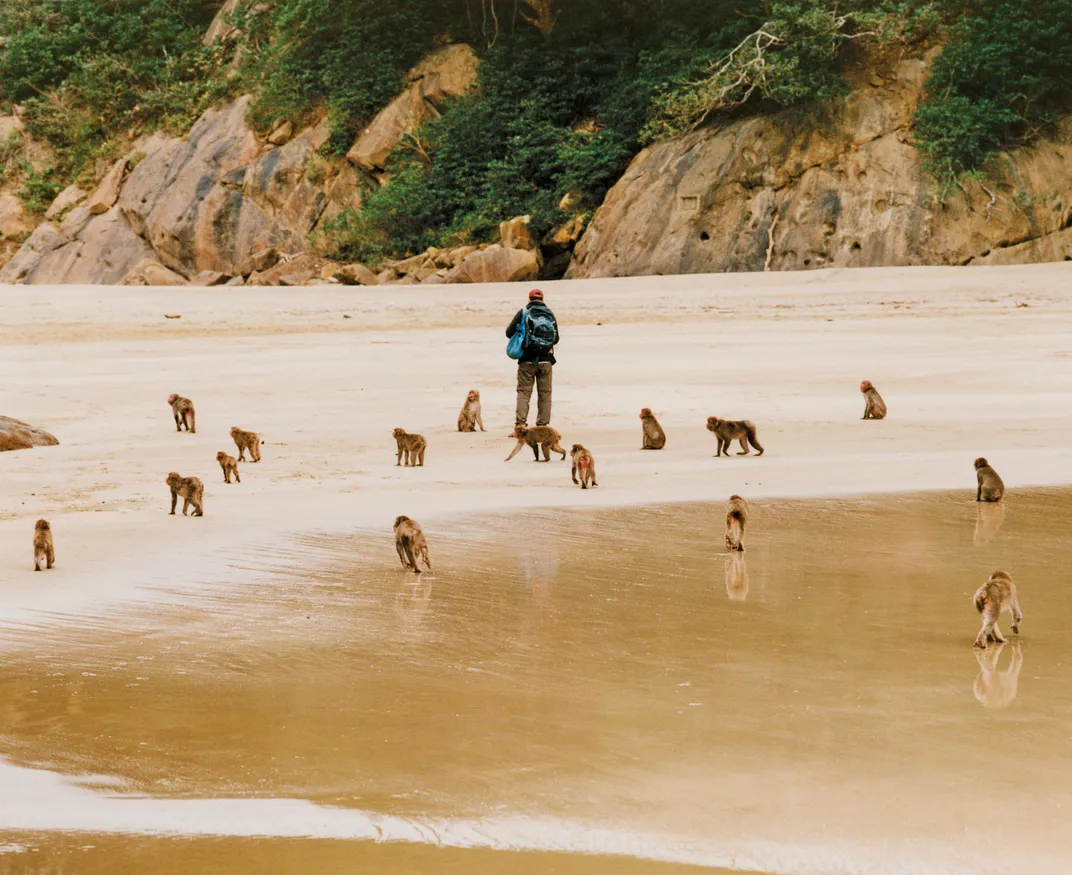
Imanishi and his students arrived on the same beach in 1948. They were looking for evidence of “pre-culture” in animals, some fundamental process that might also be the evolutionary root of humans’ diverse and sophisticated societies. Their goal was to research how “a simple behavioral mechanism has developed into a higher complex one,” wrote Syunzo Kawamura, a student of Imanshi’s. They started their research nearby on semi-wild horses and switched to monkeys after they noticed how well-organized their troop was. They met a local teacher named Satsue Mito, who was familiar with the monkeys of Koshima. In 1952, she helped them provision 20 monkeys with grain and sweet potatoes on forest trails and the beach.
It was unusual for researchers to feed wild animals, but there were a lot of things unusual about the research Imanishi planned. He needed to make the monkeys tolerant of human observers, so they could identify every individual animal and make detailed observations on their behavior and social relationships over multiple generations. It would be another decade before Western scientists like Jane Goodall and Dian Fossey started to look at apes this way. Most Western scientists had been drilled to never anthropomorphize animals. They gave them alphanumeric identities instead of names and hadn’t undertaken long-term observations: They thought individual animals were interchangeable and lacked the minds for complex social relationships.
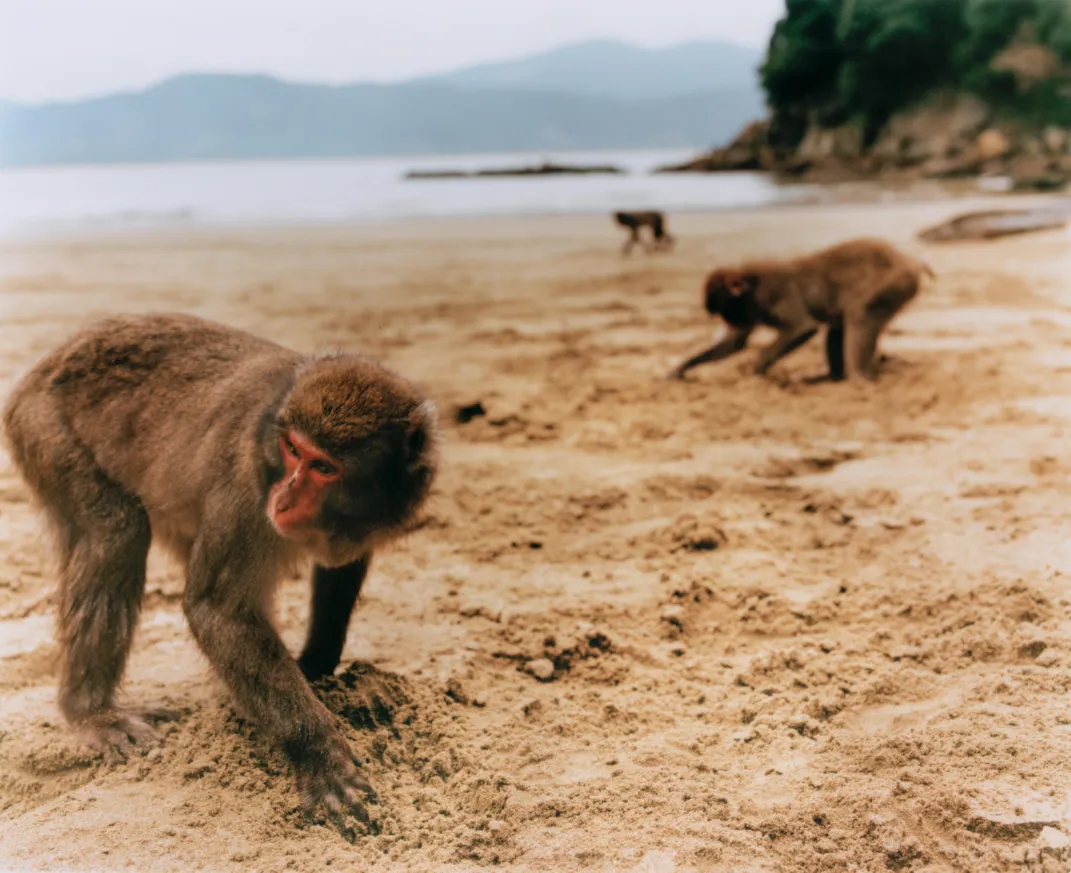
Pushed too far, anti-anthropomorphism started to resemble another well-known bias: anthropocentrism, or the belief that humans occupy a unique place at the center of the world. Modern Western science developed in societies with ancient beliefs about human’s supremacy over animals, the Dutch primatologist Frans de Waal has noted. The religious traditions in Japan, by contrast, gave humans no special status. “Japanese culture does not emphasize the difference between people and animals,” the Japanese primatologist Junichiro Itani once wrote. “We feel that this has led to many important discoveries.”
* * *
After the monkeys had finished the grain from Suzumura on Koshima, they started grooming on the beach. They relaxed into unself-conscious poses. Some flopped lengthwise on the sand while a companion hunched over them, like Orpheus mourning Eurydice. Others lay limp over rocks like sacrificial victims. One watched me coyly over her shoulder; another, haughtily down her nose. Mothers held their infants to their breasts in the manner of every Madonna and child I had ever seen.
While I tried to get as close to the monkeys as possible with my smartphone camera, Suzumura collected feces samples from the sand with a pair of chopsticks. He kept detailed records of every monkey on the island. He could identify each of them, telling you its name, age, social rank, matriliny and personality. The records stretched all the way back to Imanishi’s time, tracing the life history of every individual monkey on Koshima for over 70 years. Cumulatively, they showed how some monkey families had risen to dominance while others had disappeared. Imanishi and his students were the first to realize that monkeys maintained close alliances with relatives throughout their lives—hence were “nepotistic.” It was exactly the type of complex social order from which Imanishi predicted culture would emerge.
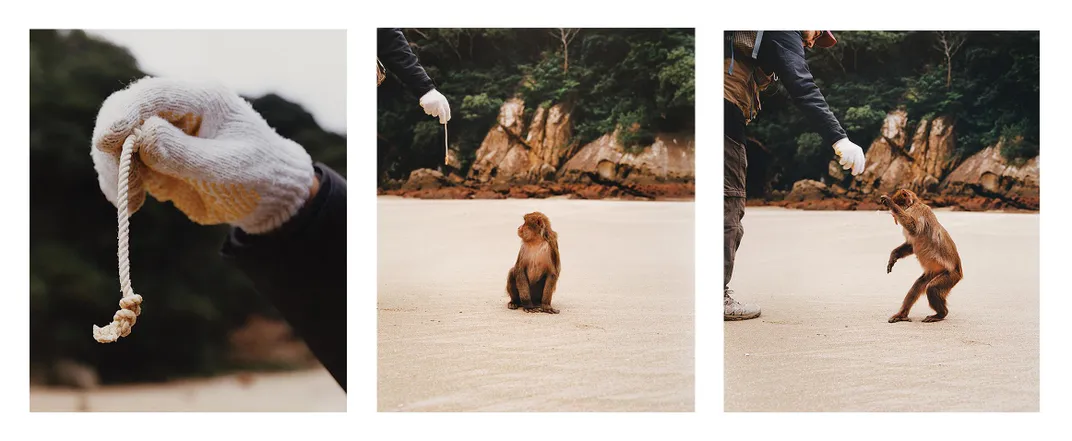
Imanishi and his team had been on Koshima for five years when one day they watched a 11/2-year-old monkey named Imo take a sweet potato and carry it to the edge of a stream. She dipped the potato in the water and wiped the sand from its skin. It may have tasted better that way, because she continued to clean her potatoes. The first monkeys to copy Imo were two who spent a lot of time near her: her mother and a playmate. Soon her relatives tried it too, and their playmates copied them in turn. Sweet-potato washing became the rage among younger monkeys. By 1958, 15 of the 19 juvenile monkeys were washing their potatoes.
Masao Kawai, another of Imanishi’s students, described this phase as “pre-cultural propagation.” Imo had innovated a new behavior that spread to her peers. Age and sex both influenced its transmission: Younger monkeys and females were more likely to learn potato washing than adult monkeys and males. The next stage began when Imo and her peers matured and reproduced. Now the behavior spread to the next generation with every new baby, males as well as females, learning sweet-potato washing from its mother. Age and sex were no longer factors. “Pre-cultural pressure is working,” Kawai wrote. A new behavior had become fixed within the troop.
By 1961, most of the monkeys had switched from washing their potatoes in the stream to the sea. This may have been because the sea’s water was more plentiful, though scientists thought they might like the flavor of the saltwater better: Some dipped the potato after every bite.
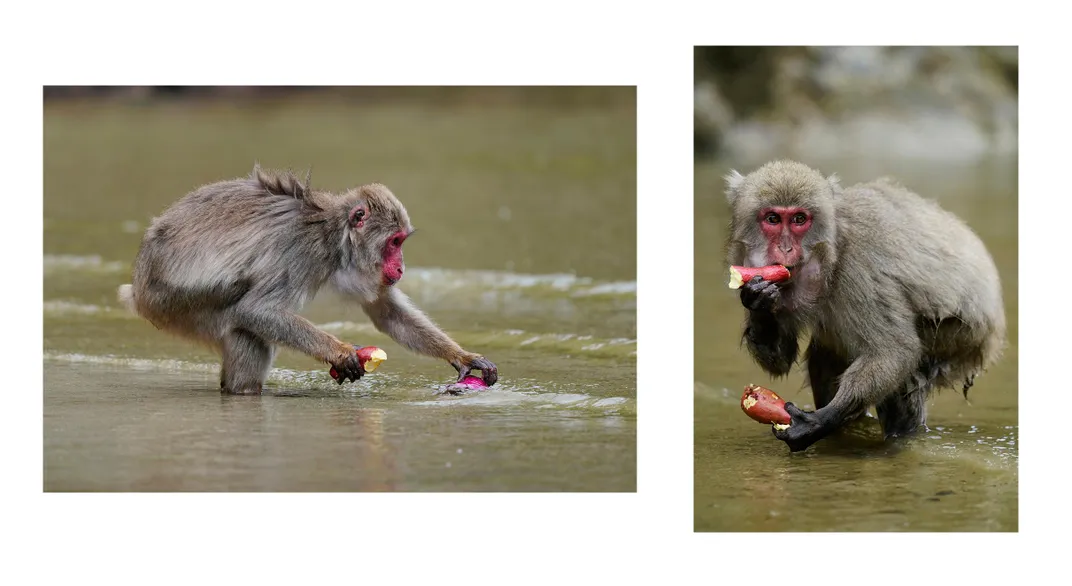
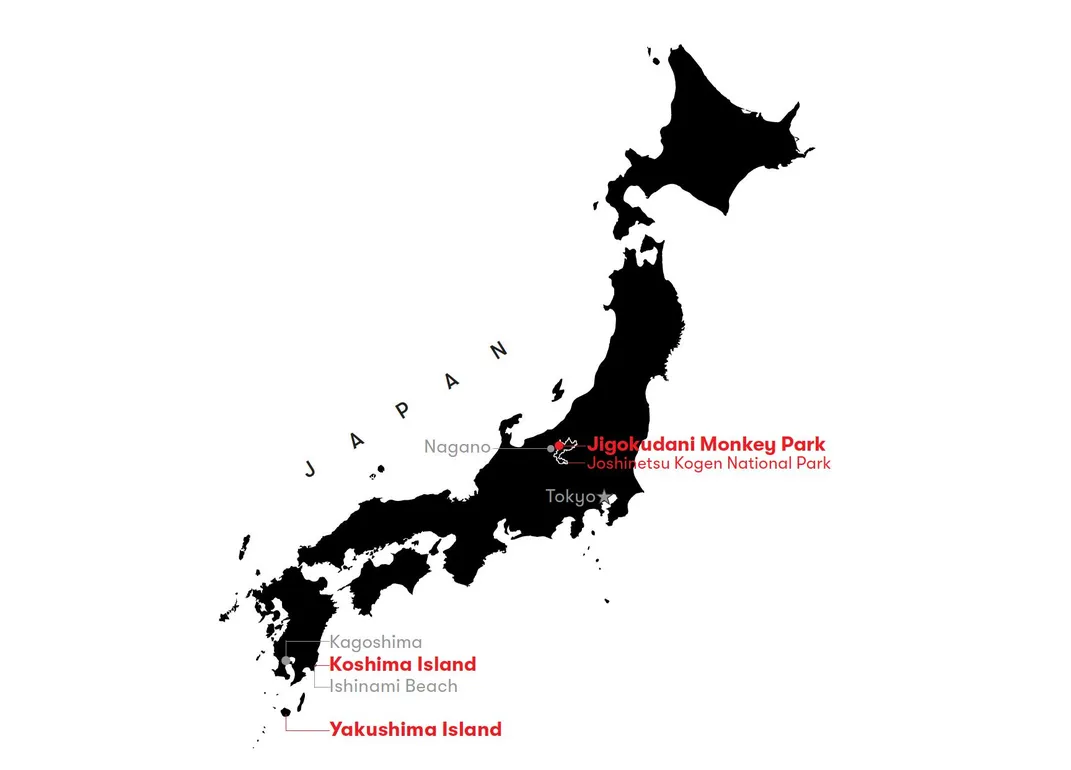
I had hoped to watch the current population of monkeys on Koshima wash their sweet potatoes, but Suzumura now fed them sweet potatoes only once or twice a year. The original group of 20 monkeys grew to 120 by 1971. In 1972, the Primate Research Institute switched to provisioning only with grain. The cultural impact of sweet-potato washing was still visible on Koshima, however. The fastidious little Imo had developed another new behavior that spread quickly through the group: She separated wheat from sand by throwing it in the water. The grain floated and the sediment sank. (Some of the monkeys still wash their wheat, Suzumura said, but none did when I visited.) And babies whose mothers carried them into the water during potato washings started to swim during playtime, something their elders had never done.
Before Imanishi’s team arrived, the monkeys spent nearly all their time in the forest. Now they were also spending much of their time on the beach and had learned a new repertoire of behaviors. “Since the scientists first started feeding the macaques on Koshima island, a whole new life style has developed,” the Israeli researchers Eva Jablonka and Eytan Avital wrote. They called it an example of “cumulative cultural evolution.” Kawai was surprised by how quickly the monkeys adapted to the beach, given their initial aversion to the water. “We learn through the Koshima troop that once that strong traditional conservatism began to break down by some cause or others, it can easily be removed,” he wrote.
The monkeys lounged on the beach for several hours when I visited. It was afternoon when the temperature started to drop, and they disappeared into the forest to forage. The empty beach might have appeared underwhelming compared with “cultural heritage sites” in the human world, like palaces and cathedrals. The monkeys hadn’t built anything that looked like architecture, not even a sand castle. What Koshima showed us, however, was that culture was not a product. It was a process. Step by step, the lives of the monkeys at Koshima had started to look different from the lives of other monkeys—and, at the same time, started to appear a little more like our own.
* * *
I had to choose where to go after Koshima. There were other sites that could qualify as cultural heritage for Japanese macaques. At Arashiyama near Kyoto, some monkeys started to play with stones in the 1970s and the behavior spread in the same pattern as sweet-potato washing at Koshima and bathing at Jigokudani: first horizontally among peers and then from one generation to the next. The scientist who first observed the behavior, an American named Michael Huffman now at the Primate Research Institute, noticed different groups of monkeys developing their own ways of handling stones over time. In some groups, the monkeys rubbed the stones together; in others, they cuddled the stones or banged them on the ground.
But I was curious to see monkeys that had never been fed by people. The Japanese researchers realized the new behaviors at places like Koshima, Jigokudani and Arashiyama weren’t exactly natural. The scientists themselves had sparked their development through feeding, which brought the animals into unfamiliar habitats and gave them downtime to try out new behaviors. Feeding also affected the life of the group in other ways. “In the feeding places, the relations among males was very clear. One is dominate, another is subordinate,” Yukimaru Sugiyama, a former scientist from the Primate Research Institute, told me. When he followed monkeys into the forest, however, young males often sat near the same dominant monkeys they had avoided at the feeding site.
As researchers became more interested in the natural lives of the primates, they learned to habituate them simply by following them. The primates ran away at first but many eventually lost their fear of humans. Starting in the late 1950s, Imanishi and his students took what they had learned in Japan and went to Africa to study chimpanzees, gorillas and other primates. Through a combination of field observation and experimental work, they verified and advanced much of what they had learned about culture from monkeys in Japan. Thanks to similar work by people like Goodall, Westerners came around to their techniques and findings.
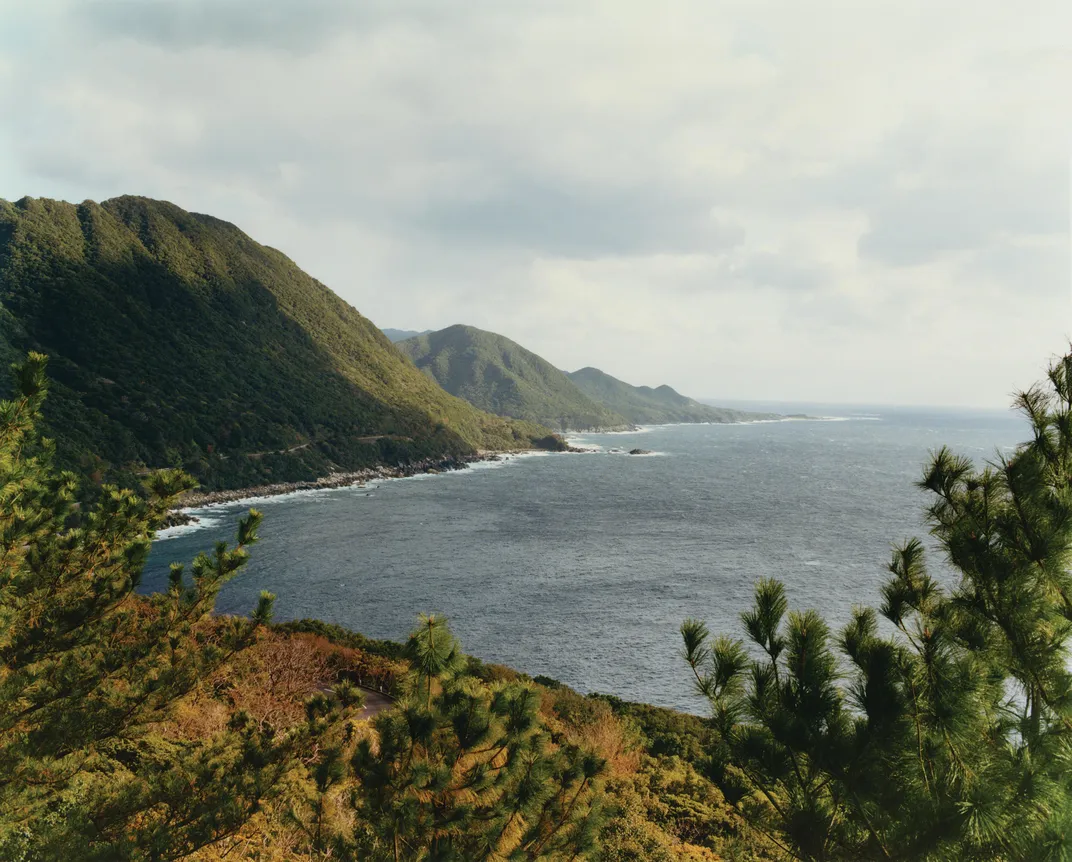
I couldn’t follow their footsteps all the way to Africa, so I went to another island called Yakushima instead. You could fly to Yakushima or take a high-speed ferry, but I chose the most economical option: a 13-hour overnight cargo ship from Kagoshima, a city next to a volcano at the southern tip of Kyushu. The island looked foreboding as we pulled into port the next morning, its mountains ringed in mist and rain. Yakushima was famous for its ancient moss and old-growth forests. About 10,000 Japanese macaques also lived on the island—about the same as the human population of around 13,000. The monkeys lived in groups of fewer than 50, and none was provisioned. They foraged for fruit, leaves, acorns and shoots as well as insects and spiders.
“On Yakushima, monkeys love mushrooms,” said Akiko Sawada, a research fellow from Chubu University Academy of Emerging Sciences. The Yakushima monkeys ate more than 60 different varieties, and Sawada was studying if they could smell whether a mushroom was poisonous. She also thought it possible that this was social knowledge, with a young monkey learning which mushrooms to eat and which to avoid by watching its mother and other adults. It was difficult to say if a behavior at Yakushima was cultural or had been learned some other way, like instinct or simple trial and error. All of these processes worked together to shape a monkey’s life, and in a completely natural setting could not easily be unraveled.
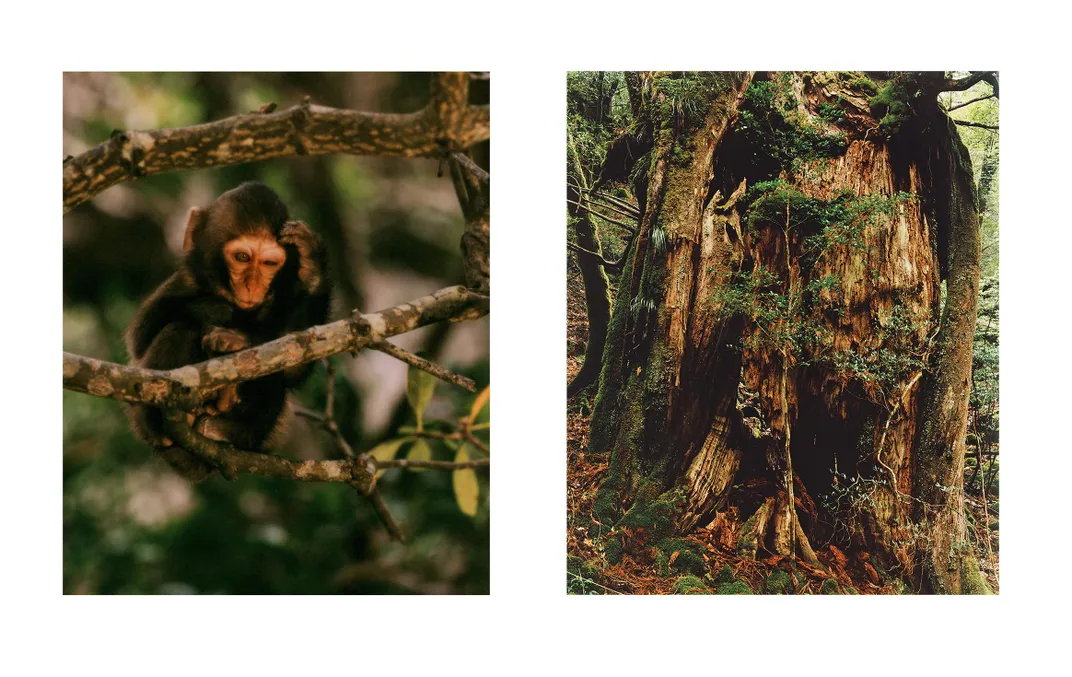
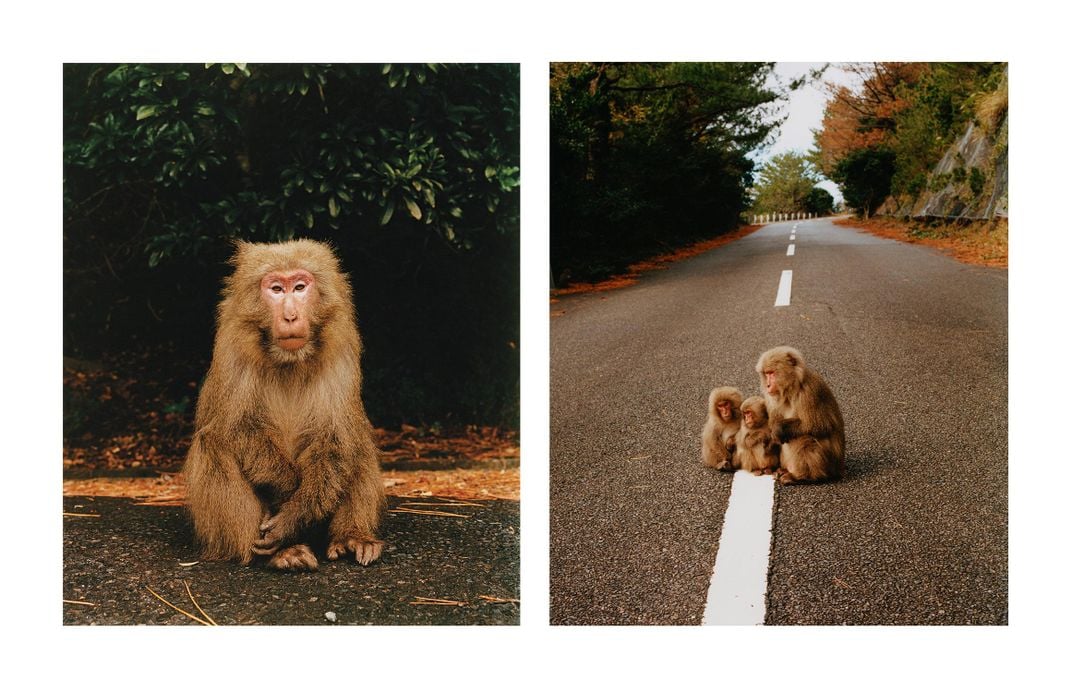
Sawada took me to the quiet western coast of Yakushima, where scientists had habituated several monkey groups. The monkeys were easy to find, as they liked to groom and sunbathe on the road. They hurried out of the way for cars that sped along but barely budged for cars that slowed down. It was also mating season, and males and females paired off to consort at a distance from jealous peers. Sawada pointed out how one of the older monkeys leaned back and looked down her arms when she groomed a partner: Her vision was getting worse.
We followed a large group from the road into the forest. Professor Sugiyama was right: There was less conflict as the monkeys spread out over a wide area to forage. Some cracked acorns with their teeth; others climbed trees for fruit. A young female unrolled curled dead leaves from the forest floor. “I think she’s looking for cocoons,” Sawada said.
Four deer joined us on the hike. They were as small as dogs and nearly as unafraid of people. The monkeys were messy eaters, and deer followed them to pick up their scraps. A relationship developed, and monkeys sometimes groomed and rode the deer. At another research site near Osaka, monkeys sometimes even mounted deer in a rare example of interspecies sex. It’s possible that the deer were gentle partners for small-bodied adolescents who were routinely rejected by the opposite sex or risked physical harm from aggresive adults. “Future observations at this site will indicate whether this group-specific sexual oddity was a short-lived fad or the beginning of a culturally maintained phenomenon,” the researchers there wrote.
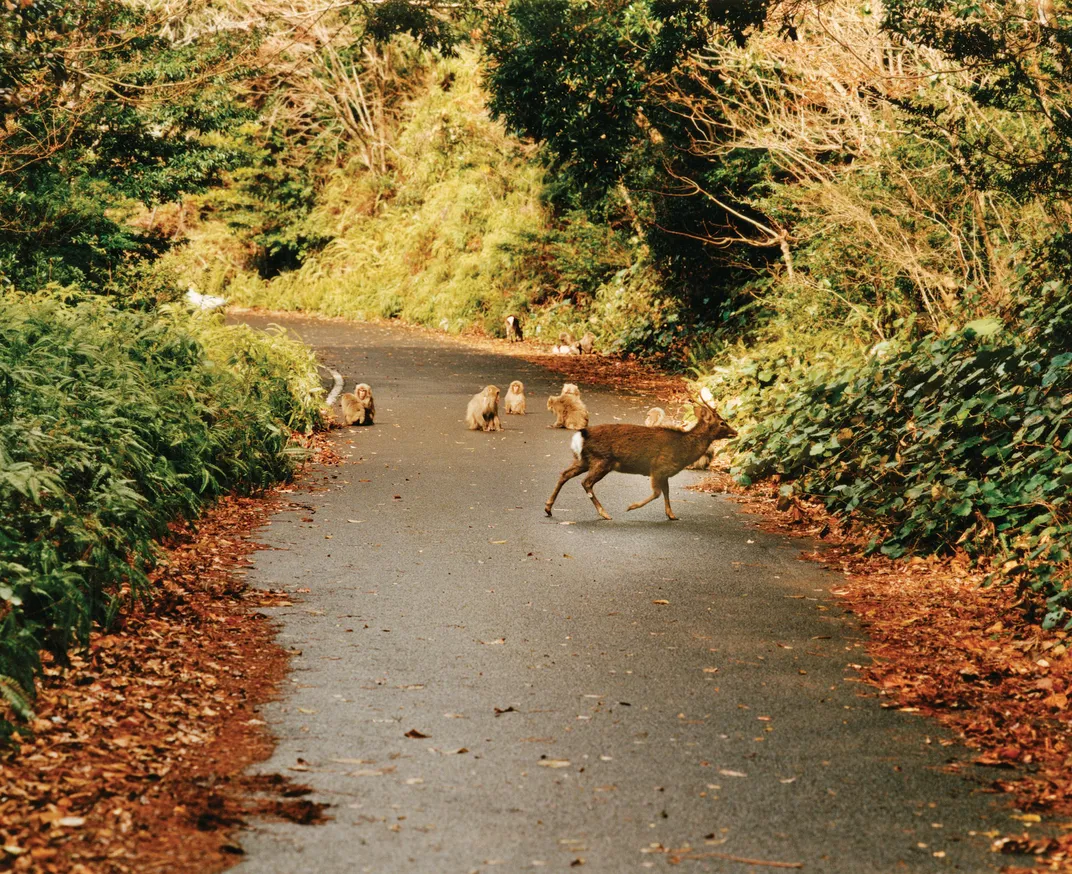
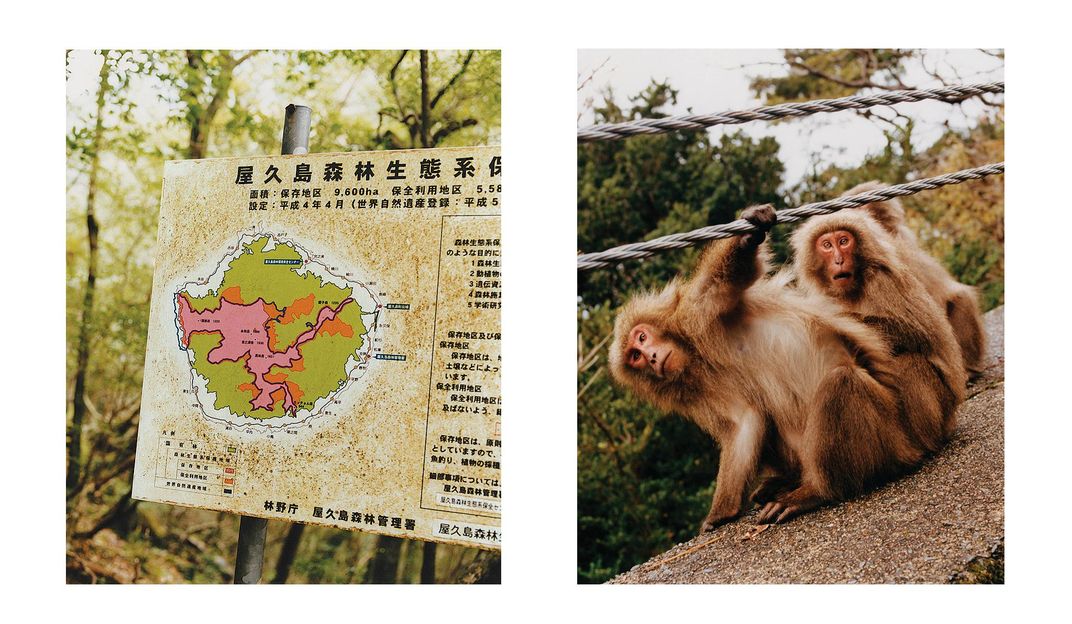
That afternoon, Sawada showed me videos of different monkey behaviors she and her colleagues had recorded in the forest. In one, a monkey devoured a giant centipede; in another, a monkey rubbed a caterpillar between her hands to remove its stinging quills before she ate it; in a third, a monkey plucked plump white hornet larvae from a nest. Sawada giggled as she played a video of the monkeys who lived at high altitudes and ate bamboo: They were, for reasons no one really understood, extremely fat.
Later, when I climbed the mountain on my own, there were no bamboo groves or chubby monkeys at the stony peak. I looked down on the canopy of the ancient cedar forest and out across the sea, thinking about what the primatologist Itani had observed—that Japanese culture doesn’t make a strong distinction between people and animals. In the West, culture and science often seem like separate forces, but here they were mutually reinforcing. Science had deciphered macaque culture, and culture had broadened our scientific understanding of the animal world.
/https://tf-cmsv2-smithsonianmag-media.s3.amazonaws.com/filer/1d/05/1d0538db-1c84-4d6d-a03f-d270615f6cc1/mobile_-__-janfeb2021_d30_snowmonkeys_copy.jpg)
/https://tf-cmsv2-smithsonianmag-media.s3.amazonaws.com/filer/9a/58/9a58c20a-667f-47bb-9fe9-58acad201abd/opener_-_snow_monkeys.jpg)